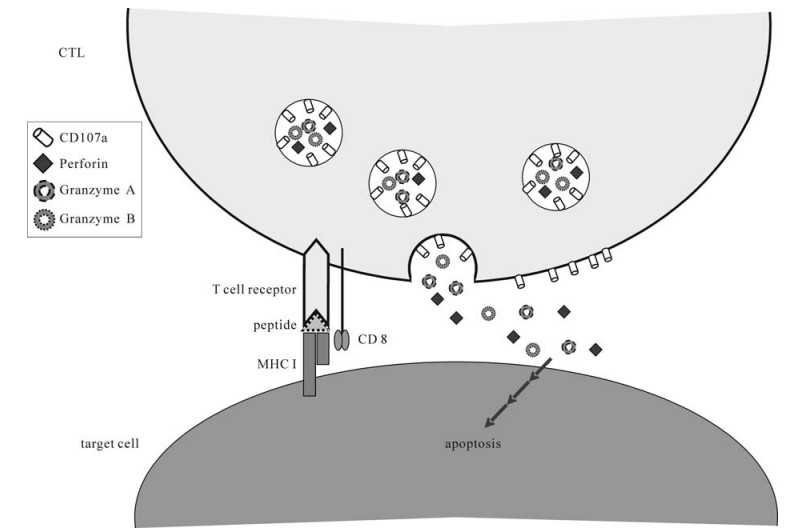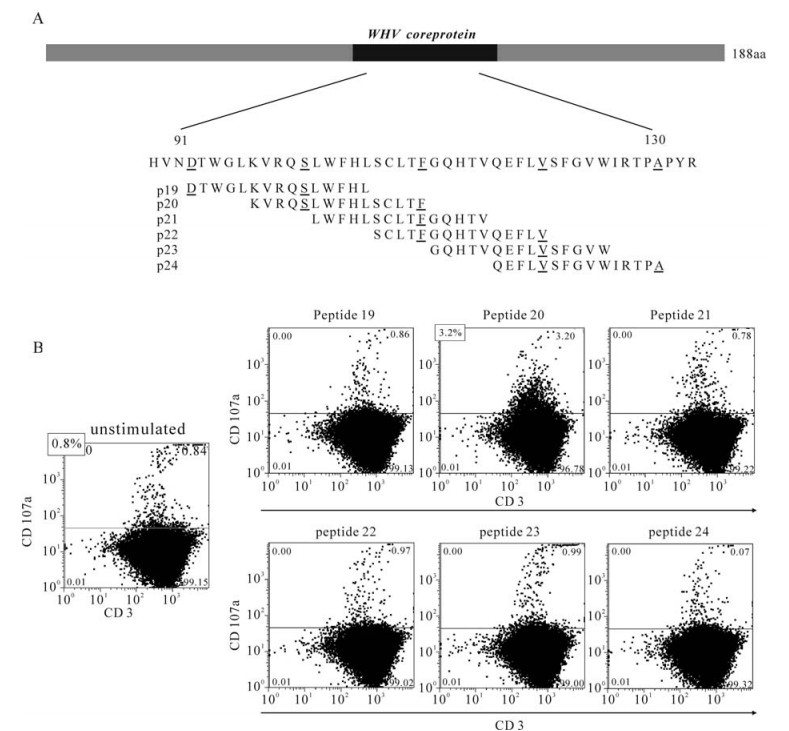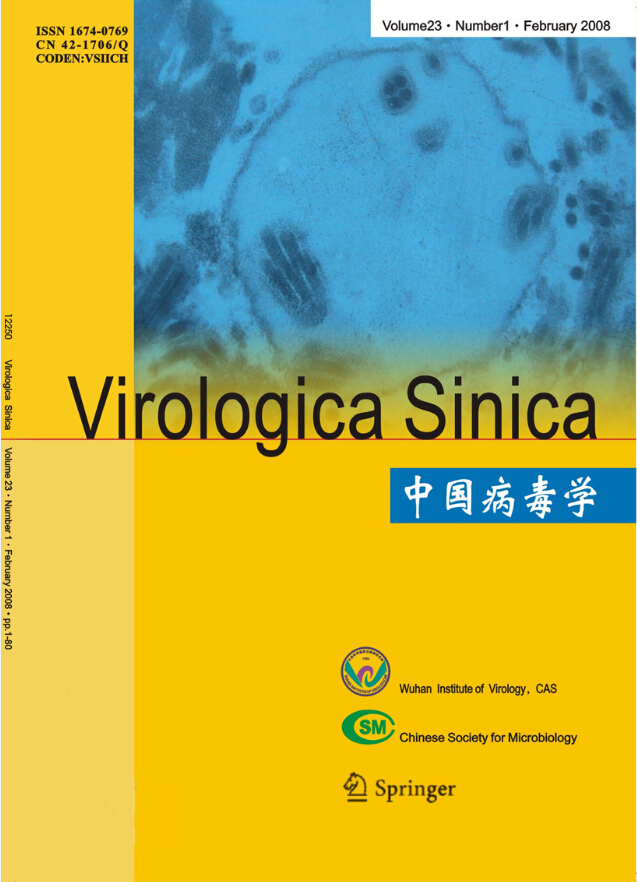-
Woodchucks (Marmota monax) infected with woodchuck hepatitis virus (WHV) are a well estab-lished model for hepadnaviral infection. WHV is a member of the family Hepadnaviridae and was discovered in the early 80s as a genetically closely related virus to HBV [42]. The acute and chronic WHV infections in woodchucks show similar serolog-ical profiles and features in pathology like HBV infections in humans. Several questions have been addressed in this model, especially immunopathogenesis, new vaccination trials and innovative thera-peutic approaches [24, 26, 39, 40]. For the optimal use of this model, a comprehensive characterization of host immune responses against viral antigens is needed. For a long time, only assays for serological parameters of WHV infection were available and it was not possible to monitor antigen-specific T cell responses in woodchucks [36, 49]. To overcome this limitation and make use of woodchucks for immuno-logical studies, many efforts were made to develop and improve the woodchuck model for investigations on T cell responses since the beginning of 90s. The progresses in the woodchuck model were summarized in previous reviews [26, 39]. In this paper, we focus on the recent results including the establishment of a new assay to detect cytotoxic T lymphocytes (CTLs) in woodchucks and therapeutic approaches against chronic hepadnaviral infections.
HTML
-
One important step in the study of T-cell responses in the woodchuck model was the establishment of in vitro assays for the measurement of lymphoprolife-rative activities against WHV antigens using peri-pheral blood mononuclear cells (PBMCs) [8, 20, 31]. The inability of woodchuck lymphocytes to incorporate exogenous thymidine was an unexpected obstacle [29]. Purines like adenosine and deoxyadeno-sine are efficiently incorporated by proliferating woodchuck PBMCs. Today, assays using adenosine are routinely used for detection of specific lym-phoproliferative response to viral antigens during acute and chronic WHV infection and following immunizations with protein and DNA vaccines [30, 31].
For the optimal use of this animal model, however, determination of the immune response by virus-specific CTLs is required. Previous attempts to apply standard detection techniques like the chromium release assay or gamma interferon (IFNγ) staining to the woodchuck system have not been successful yet due to technical reasons. A novel method for the detection of the cytolytic effector function of virus-specific CTLs was established by Betts et al. [4]. The flow cytometric degranulation assay is based on the staining of the membrane protein CD107a which is presented on the surface of CTLs after recognition of the infected target cell and initiation of killing mechanisms (Fig. 1). This technique was transferred to the woodchuck model recently [11].

Figure 1. The principle of CD107a degranulation assay. Killing of target cells is mediated either via a granule-dependent or viaindependent mechanism. The granule-dependent pathway utilizes pre-formed lytic granules which are located within the cytoplasm of cytotoxic cells. The lipid bilayer surrounding these granules contains lysosomal associated membrane glycoproteins (LAMPs), including CD107a (LAMP-1). Rapidly upon recognition of the infected target cell via the T cell receptor complex, apoptosis-inducing proteins like granzymes and perforin are released into the immunological synapse, a process referred to as degranulation. Thereby the transmembrane-protein CD107a is exposed to the cell surface and can be stained by specific monoclonal antibodies.
In pilot experiments, it was shown that stimulated woodchuck cells can be stained with an anti-mouse CD107a antibody. This staining was enabled by an anti-mouse CD107a antibody cross-reactive to wood-chuck CD107a. The cloning and sequencing of a major part of woodchuck CD107a revealed high protein sequence similarities to murine, human, and nonhuman primate CD107a of approximately 80%, which may explain the cross-reactivity of the anti-mouse CD107a antibody.
In order to determine WHV-specific CTLs, an in vitro restimulation protocol followed by surface staining was established. Therefore, splenocytes of animals that had resolved the infection were subjected to analyses. Spleen cells are frequently used in mouse immunology to demonstrate virus-specific CTLs during acute infections. In addition, memory T cells are assumed to be present in the spleen after resolved infections. The expansion and degranulation of wood-chuck CD3+ T cells after stimulation with WHV-derived peptide pools and single peptides was demonstrated. For a more detailed characterization of degranulating T cells, staining with antibodies to CD3 and CD4 was performed, since an antibody to woodchuck CD8 is not yet available. Three-color flow cytometry enabled the identification of degranulating CD3+ T lymphocytes as CD4+, which suggests that the analyzed cells are CD8+ T lymphocytes. In accordance with many publications the expression of the degranulation marker CD107a has been shown for the population of CD8+ T lymphocytes [41, 53]. Hence, with this flow cytometric degranulation assay the detection of WHV-specific CTL was rendered possible for the first time.
For the identification of epitopes within the WHV core antigen (WHcAg) and WHV surface antigen (WHsAg) lymphocytes from acutely WHV-infected or immune woodchucks were stimulated with single peptides of these proteins (Fig. 2A). With this newly established assay, one CTL epitope within the WH-cAg aa 96-110 was identified (Fig. 2B). The existence of a single MHC-I-restricted epitope in the nucleo-capsid is consistent with previous findings of human MHC-I-restricted epitopes of HBV core protein. The unique HLA-A2-restricted HBV core peptide is located at amino acids 18 to 27 (3; for a review, see reference 6). Furthermore, HLA-A31-and HLA-Aw68-restricted CTLs recognize only HBV core peptide 141-151, as shown by Missale et al. (32; for a review, see reference 6). Most of the animals that were analyzed recognized the identified epitope despite their outbred background, implying that these animals had the same MHC-I background. However, preliminary MHC-I typing results do not suggest the presence of a frequent allel. The MHC-I genes of woodchucks, termed Mamo I, are similar in their molecular structure to those of humans and other mammals. Up to now, 20 different alleles of Mamo I genes have been identified [54].

Figure 2. Degranulation response of splenocytes from a woodchuck that had resolved WHV-infection. Splenocytes were isolated, stimulated in vitro with 6 different peptides derived from the WHcAg for 6 days as indicated and subsequently subjected to the CD107a degranulation assay. A: The peptides derived from WHcAg. B: Degranulation response induced by the peptide 20 (aa 96-110).
Screening of the complete WHsAg with overlap-ping peptides led so far to the identification of at least one peptide as a potential CTL epitope. In contrast, within the surface protein of HBV there have been reported eleven CTL epitopes [33]. Further experi-ments need to be carried out to characterize the WHsAg-specific CTL response in more detail.
The MHC class Ⅰ-restricted CTL response is thought to play a key role for the control of hepadna-viral infection and the elimination of the virus. On the one hand, in several studies it was shown that the CTL response to HBV in peripheral blood is polyclonal and multispecific in patients with acute viral hepatitis who have successfully cleared the virus [2, 28, 38, 44]. Therefore, the kinetics of peripheral blood CTL appearance during the acute and post-acute phases of WHV infection were investigated. As late as 6 weeks after infection the peak T-cell response was observed and coincided with viral clearance. This is in line with previous studies with HBV-infected humans and with HBV-infected chimpanzees, where it was shown that virus-specific CTLs can be detected late after in-fection at the onset of viral clearance [13, 46, 47]. On the other hand, patients that are persistently infected with HBV display a weak and oligoclonal CTL response to viral antigens. Studies with chronically WHV-infected animals confirm these findings, as the absence of CTL responses to the WHcAg derived peptide was determined.
-
Approximately 400 millions people worldwide are chronically infected with hepatitis B virus (HBV). The currently available therapy with interferon (IFN) may lead to virus elimination. However, it is only success-ful for a minority of patients and is associated with side effects. The introduction of pegylated IFN-α alone or in combination with nucleoside analogues did not significantly increase the rate of sustained re-sponders [17, 18, 21]. The treatment with nucleoside analogues like lamivudine, adefovir, and entacavir may improve the clinical conditions of chronically HBV-infected patients, e.g. delaying the progress of liver cirrhosis, but does not lead to the complete elimination of HBV and is hampered by drug-resistance development [22, 37].
Several clinical trials for immunotherapy against chronic hepatitis B using conventional alum-adsorbed HBV vaccines were published in recent years [9, 16, 19, 34, 35, 51]. However, a seroconversion to anti-HBs positive or a sustained suppression of HBV replication was rarely documented, indicating that the immunotherapy with conventional HBV vaccines did not achieve a satisfactory result. The available vaccines are designed to prime antibody responses and obviously not effective to stimulate CTL-mediated immune responses. The crucial role of HBV-specific CTLs on the control of HBV infection has been demonstrated in HBV infected chimpanzees [13, 45]. In addition, the HBV load and liver injury had been reported to be reciprocal to the specific CTL responses in chronically HBV infected individuals [27, 43]. These results suggest that it may be valuable to include components in new vaccines to stimulate specific CTL responses to HBV.
The recent studies on the immunological me-chanisms of the control of HBV infection provided a basis for the development of therapeutic vaccines. It should be emphasized that a multispecific immune response is required for the control of HBV infection [6]. All branches of the immune system besides specific CTLs contribute to the sustained control over HBV. Thus, therapeutic vaccines should induce all effectors involved. This concept suggests that effective therapeutic vaccines should be a combination of different components like DNA expression vectors, viral antigens, cytokines, and adjuvants.
Several studies of therapeutic vaccinations mainly based on the protein vaccines have been carried out in the woodchuck model (reviewed in 26, 24, 39, 40). Different immunotherapeutic approaches using WHV surface antigens (WHsAg) in combination with a helper peptide, or with the adjuvant monophosphoryl lipid A, or in combination with antiviral treatment were tested experimentally to evaluate the efficacy [14, 15, 25, 30]. The previous studies showed collectively that B-or T-cell responses to viral antigens could be induced in chronic WHV carriers. Yet, the value of vaccines for the suppression of viral replication was not obviously recognizable in these studies.
A promising therapeutic vaccine based on antigen-antibody immune complex (IC) was developed by the group of Wen et al. [48]. In a previous pilot tiral, immunizations with IC resulted in a significant reduction of HBV DNA concentrations in 9 out of 14 HBV-infected patients that were below the detection limit. However, these patients remained HBsAg positive and anti-HBs negative. Recently, IC has been shown to be a potent inducer of anti-HBs in a clinical phase Ⅰ and Ⅱ study [50, 52]. The ability of IC to efficiently stimulate the specific immune responses may be explained by enhanced uptake of HBsAg by antigen-presenting cells that then leads to an improved function of APC and stimulation of T-cells. To further improve the efficacy of IC immunization, a triple combination of antiviral treatment with lamivudine and therapeutic vaccination with antigen-antibody complexes was carried out in the woodchuck model [23]. Three woodchucks receiving the combination of WHsAg-anti-WHs complex and pWHsIm developed anti-WHs antibodies and showed a further decrease of serum WHV DNA and WHsAg concentrations be-yond that induced by lamivudine. The anti-WHs antibodies persisted in two woodchucks for a total of 8 weeks. These encouraging results indicated that the triple combination therapy is a good base of future development of effective treatment options against chronic HBV infection. In a new experiment, we combined the treatment with the potent antiviral drug entecavir and 6 immunizations with a protein-DNA vaccine. Entecavir has been shown to be very effective to suppress WHV replication in woodchucks chronically infected with WHV and led to a sup-pression of WHV DNA under the detection limit within few weeks [7]. The immunizations with DNA vaccines expressing WHsAg/WHcAg or DNA vac-cines plus protein vaccines (WHsAg/WHcAg) were started after the virus became undetectable and were repeated in time intervals of 2 to 4 weeks. After the ceasation of entecavir treatment, a rebound of WHV replication took place immediately in wood-chucks treated with entecavir alone. Interestingly, viral rebound was only observed in vaccinated wood-chucks after ceasation of vaccination. Particularly, 3 of 6 vaccinated woodchucks remained WHV DNA negative for at lease 12 weeks, suggesting that a combined treatment against WHV may lead to a prolonged suppression of viral replication. Again, vaccinations contributed significantly to viral suppres-sion, even after the discontinuation of antiviral treatment.
The present work done in the woodchuck model has proven the feasibility of therapeutic vaccination against chronic HBV infection. Particularly, immuni-zations with immune complexes and DNA vaccines appear to be an effective method to stimulate antibody responses with antiviral efficacy. Further efforts will focus on the induction of sustained immune responses to maintain long-term control of viral replication. For the future development, new, more effective antiviral strategies are now under investigation. For example, short interfering RNA (siRNA) has been shown to be active to inhibit the hepatitis B virus gene expression and replication in transient and stable transfection systems. In a new study, we tested siRNA against woodchuck hepatitis virus (WHV) in primary hepa-tocytes prepared from naturally WHV-infected woodchucks. Different siRNAs targeting different WHV genome regions were able to reduce the WHV replication intermediates and transcripts in primary hepatocytes. The inhibitory effect lasted at least for 10 days. Furthermore, siRNA-directed reduction of WHV replication could enhance the expression of antiviral proteins like MxA and MHC-I. The results demon-strated that specific siRNAs might be developed as a powerful antiviral agent for the treatment of hepatitis B.
A new area of recent research is to reverse the immune tolerance to viral antigens due to host own negative immune regulation. For example, the PD-1/ PD-L1 system may play a role for the impairment of T cell function in chronic viral infection [1, 5, 10, 12]. Now, we characterized molecularly the woodchuck PD-L1 (wPD-L1). The whPD-L1 shows a high simi-larity to the counterpart of mammalian species, with the highest similarity to whPD-L1 with 85% and 76% at nucleotide and amino acid sequence levels, respect-ively. It will be extremely interesting to test if a block of PD-1/PD-L1 system will enhance virus specific T-cell responses in woodchuck model.













 DownLoad:
DownLoad: